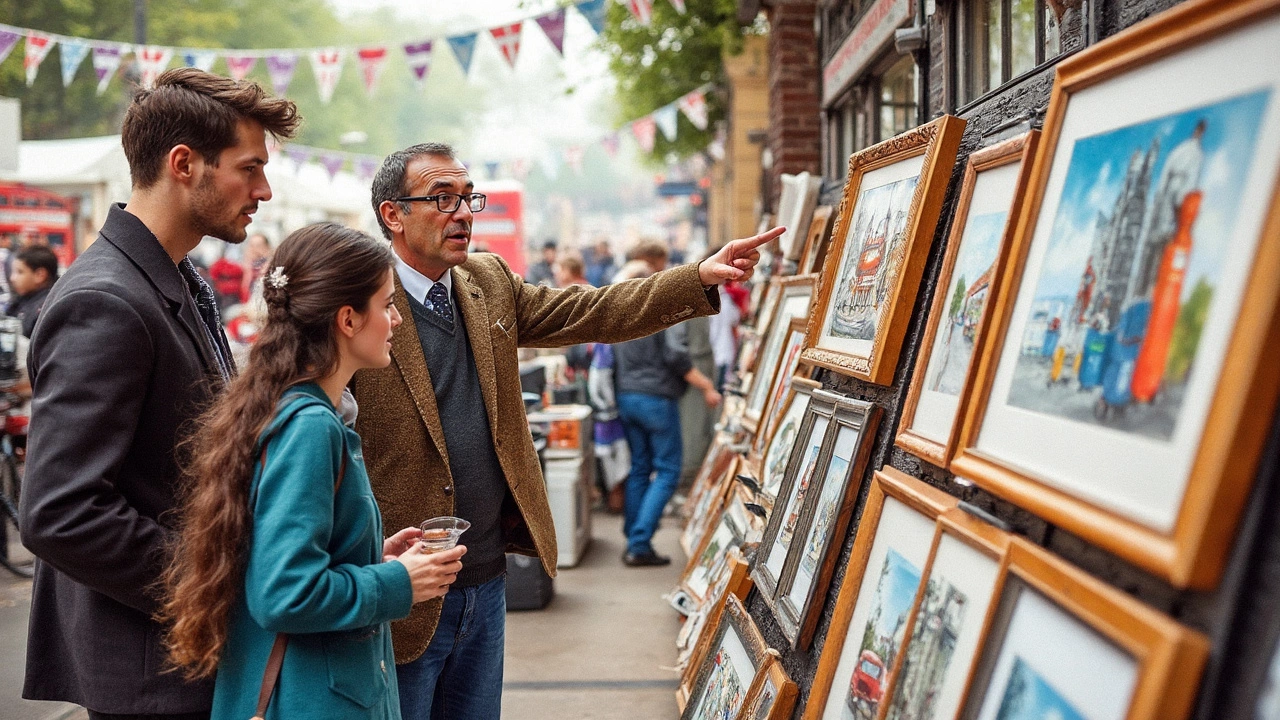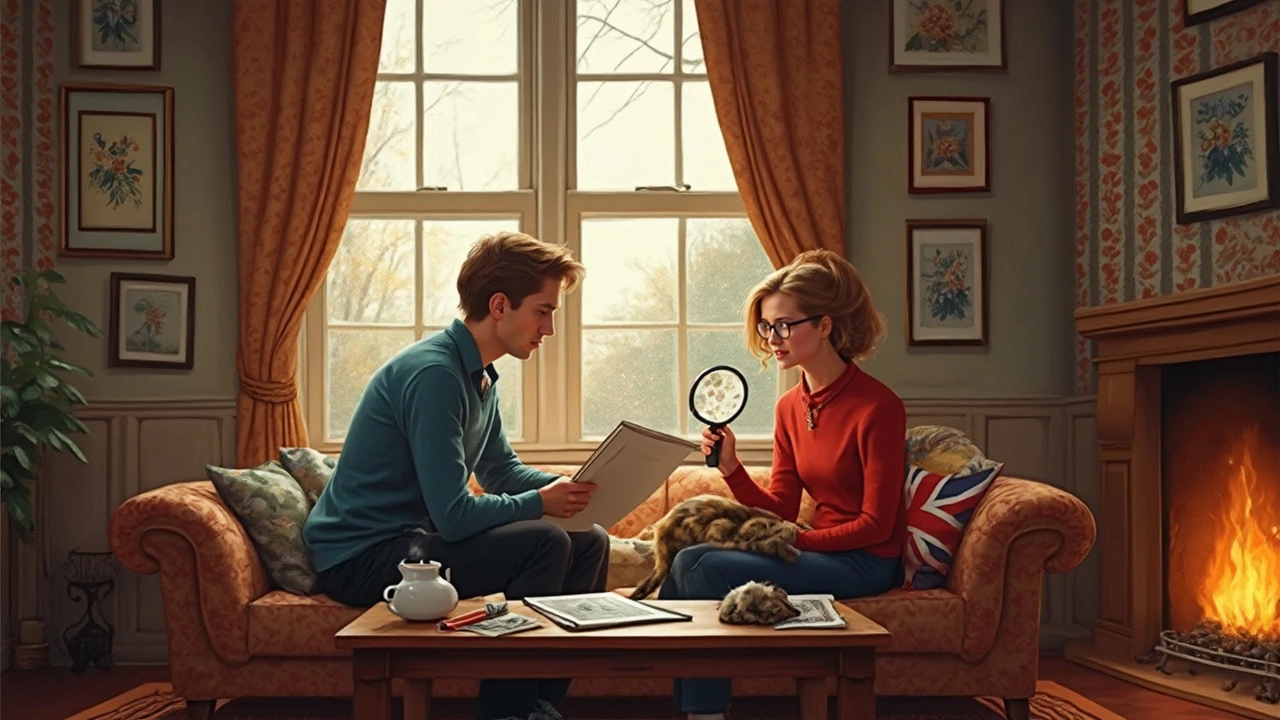Ever spotted a print with an artist’s signature and wondered if it ups the value, or if you’re just looking at some fancy scribble? You’re not alone. Tons of people stash away signed prints thinking they’ve struck gold, but prices swing wildly based on a few concrete things.
Not every signed print is a jackpot. Some signatures do add real value — but others are just marketing fluff. The trick is knowing the details: is the print limited edition or mass-produced? Is that signature actually hand-signed or part of the original print?
If you’re hoping to buy, sell, or simply understand what’s hanging on your wall, it’s important to get the facts right. Let's get past the hype and zero in on what really matters when it comes to signed art prints and their actual worth.
- Why Do Artists Sign Prints?
- How to Tell if a Signed Print is Valuable
- Common Pitfalls and Red Flags
- Buying and Selling: What to Watch For
- Quick Tips for Building Your Collection
Why Do Artists Sign Prints?
Artists don’t just sign prints for fun. The signature does a few key jobs, and it’s not just about looking official. Most of the time, when you see an artist’s autograph on a print, it’s meant to prove the piece really came from them. That signature is a sort of promise: “Yes, I saw and approved this.” For collectors and buyers, this adds a layer of trust you can’t get with unsigned or mass-produced stuff.
There’s also the whole idea of limited editions. Big-name artists and printmakers started signing their prints way back in the 19th century—think of names like Picasso and Matisse—because they wanted their prints to stand out from the flood of cheap copies. By signing and numbering each print, they showed buyers exactly how rare each one was. Suddenly, a signed run of 250 prints looks much more appealing than thousands of unsigned posters.
Check out how artists typically sign their prints:
- A signature in pencil is most common—ink can sometimes fade or bleed over time.
- Signatures often go along the border, usually at the bottom right.
- The number (like 23/150) shows how many were made and which one you have.
- Some artists add the date or even a special mark, which can boost the collectible value.
Wondering why it matters? Have a look at this quick data snapshot showing how the signature changes a print’s appeal—based on auction house results:
| Type of Print | Average Auction Price | Sell-Through Rate |
|---|---|---|
| Signed, Limited Edition | $2,100 | 78% |
| Unsigned, Open Edition | $350 | 42% |
So, if you’re looking at signed art prints, you’re often seeing something with a stronger connection to the artist, better authenticity, and—sometimes—a real bump in value. That’s why collectors chase after those signatures.
How to Tell if a Signed Print is Valuable
Let's get straight to it: spot-checking the value of a signed art print means looking way beyond the signature. While a real, hand-signed mark can help, it's just one part of the story. Here's what you actually need to check:
- Edition size matters: Limited edition prints are a big deal. A signed print that’s 1 of just 50 is almost always worth more than one from a run of 2,000. The smaller the edition, the higher the potential value.
- Technique used: Is it a fine art print (like a lithograph, etching, or screenprint), or just a digital reproduction? Collectors want prints made using traditional printmaking processes, not inkjet prints pumped out in bulk.
- Placement of signature: Sounds minor, but it matters. Real value comes when the signature is on the print itself (usually in pencil or ink, under the image or in the margin), not just in the artwork or printed with the image. If the signature is identical on every print you see, it’s probably print-signed, not hand-signed.
- Main artist factors: Is the artist up-and-coming or already established? Prices can jump if the artist has gallery shows, museum collections, or a track record of rising auction prices.
- Documentation and provenance: Serious prints have paperwork. Look for certificates, original receipts, and clear info on edition size, title, and year.
Here's a quick look at what influences value the most, using real data from the secondary art market:
| Factor | Effect on Value | Example |
|---|---|---|
| Limited Edition Size | Higher value when edition is under 100 | Keith Haring, 85/100 lithographs fetch over $10,000 each |
| Artist Reputation | More known = higher demand, higher price | Banksy signed prints regularly top $50,000 at auction |
| Authentic Signature | Hand-signed is valued 2x or more over printed signatures | Hand-signed Picasso prints sell far higher than unsigned or print-signed versions |
| Proof of Authenticity | Provenance can boost trust — and price — by 20-30% | Works with COAs (Certificates of Authenticity) get more attention from collectors |
One quick tip: Watch out for “open editions.” These are prints where there’s no cap on the number produced. Even if they’re signed, their market value is usually low unless the artist becomes super famous. And here’s another solid check—Google the artist’s past auction results, which gives a snapshot of what people are actually willing to pay for signed art prints today.

Common Pitfalls and Red Flags
This is where a lot of people slip up when they get into collecting signed art prints. It’s easy to get excited and overlook the common traps that can leave you with something that’s not worth the paper it’s printed on. Swinging between real treasure and total letdown often comes down to a few key details.
First off, just because a print has a signature doesn’t mean it’s hand-signed. Tons of prints have the artist’s signature pre-printed by machine—a common trick since the 1980s. Authenticity is everything. Always check if the signature looks like real pen or pencil on the paper, and look for pressure marks or slight indentations.
Watch out for too-good-to-be-true prices, especially online. A limited-edition signed print by a well-known artist rarely goes for less than $100, and sometimes the price soars much higher. If someone’s selling you a "limited edition" Picasso or Warhol for $40, there’s a catch—most likely a fake, a reproduction, or an unlimited run poster with a printed signature.
- Signed art prints should have clear information about the edition size. Genuine limited editions are marked with numbers like 12/100. If there’s no number, or it says something like "Open Edition,” that print’s probably not rare or valuable.
- Certificates of authenticity are nice, but easy to fake. Don’t trust a certificate alone—trust the source and do your homework about the artist and gallery reputation.
- Don’t ignore condition. Even a rare signed print loses value if it’s faded, torn, or moldy. A sharp, crisp print with a clean signature is always worth more.
A 2023 report from Art Basel showed over 20% of claims in the art market last year were about misrepresented editions or fake signatures.
| Pitfall | What to Watch For | Common Losses |
|---|---|---|
| Printed Signature | Signature looks flat, no texture | Value drops to poster level |
| Fake Limited Edition | No edition number or info | Little to no resale value |
| Unverifiable Authenticity | Sketchy certificate, unknown gallery | Hard to resell, get scammed |
| Poor Condition | Fading, rips, moisture marks | Major loss of value |
If you’re not sure, always check with a reputable gallery or ask a certified appraiser before throwing your money down. A few minutes of extra research can save your collection, and your wallet.
Buying and Selling: What to Watch For
The whole business of buying and selling signed art prints can feel like a minefield, but there are some tried-and-true things you can look out for. The most important thing? Don’t get swept up by a signature alone. Plenty of prints have scribbles that mean nothing in the market. Always keep your eyes open and know what you’re getting into.
If you want to buy, start with signed art prints from established artists or editions that are clearly numbered and authenticated. A real hand signature and a lower edition number (think 1/50, 14/100) often mean your print is rarer. Limited editions almost always hold up better in value than open editions. Never just take the seller’s word—ask for proof. Authenticity certificates are a win if they come from a trusted source.
When you’re ready to sell, get your paperwork together. Auction houses and serious buyers are going to want authentication. Prints with good provenance—meaning you can trace who bought and sold it before—stand out in a crowded market. If you inherited a print, dig up any paperwork or receipts you can find.
Watch out for red flags like prints labeled "signed in plate"—that means the signature was printed with the image, not added by the artist. Some folks try to pass these off as authentic hand-signed pieces. Another classic trap: buying from online sellers with fuzzy photos or no detailed description. If you can’t clearly see the signature and edition number, hit pause.
- Always check if the print has a real, hand-written signature—use a magnifier if needed.
- Compare signatures with reliable samples online (especially the artist’s own site).
- Look for limited edition numbers, certificates of authenticity, and gallery stamps.
- Be wary of mass-produced posters sold as “rare” signed prints.
- Trust your gut—if the deal feels shady or too good to be true, walk away.
It’s not just about landing something with a famous name; the details make all the difference. Stay sharp, do a quick bit of research, and don’t let anyone rush you. You’re building a collection, not sprinting through a Black Friday sale.

Quick Tips for Building Your Collection
Keen to grow your stash of signed art prints and skip rookie mistakes? Here are moves that actually pay off. The most important detail when looking at signed art prints is knowing what you’re really getting, right down to ink and paperwork.
- Stick with limited editions: Open editions rarely gain real value, but prints from runs under 250 copies hold stronger promise, especially when numbered.
- Check for hand signatures: If the signature looks printed or super-perfect, it’s probably not hand-signed. Flip the print to the light—real ones usually show pen or pencil marks.
- Buy what you like: Even if prices don’t rocket, it’s way easier to enjoy your collection if you actually connect with the art and artist.
- Research the artist: Head to databases like Artsy or ArtNet to see real sale prices and if their work is in museum collections. An active career and recognition bump up demand.
- Keep records: Save receipts, certificates of authenticity, gallery labels, even emails—these help prove your print’s story if you ever want to sell.
- Mind the condition: Nicks, stains, or sun fading dock value big time. Always protect prints in acid-free sleeves, away from sunlight or damp.
- Watch for fakes: A 2021 report from the Art Basel and UBS Art Market showed that more than 40% of art sellers worry about forgeries. If it looks too cheap for the artist’s usual prices, pause and dig deeper.
Curious how the pros do it? Here’s a quick snapshot of where folks actually shop for signed prints, based on a 2023 survey from ArtTactic:
| Source | % of Collectors Buying Here |
|---|---|
| Major Auction House | 38% |
| Online Marketplace (like Artsy, 1stDibs) | 33% |
| Direct from Artist | 21% |
| Local Gallery | 16% |
Building a good print collection isn’t just about hunting bargains. It’s paying attention to the story behind each piece, being picky about the details, and buying from places where you can trust the source. That’s where the actual value starts.

